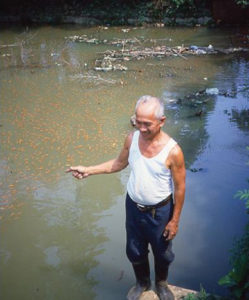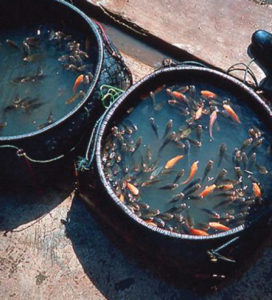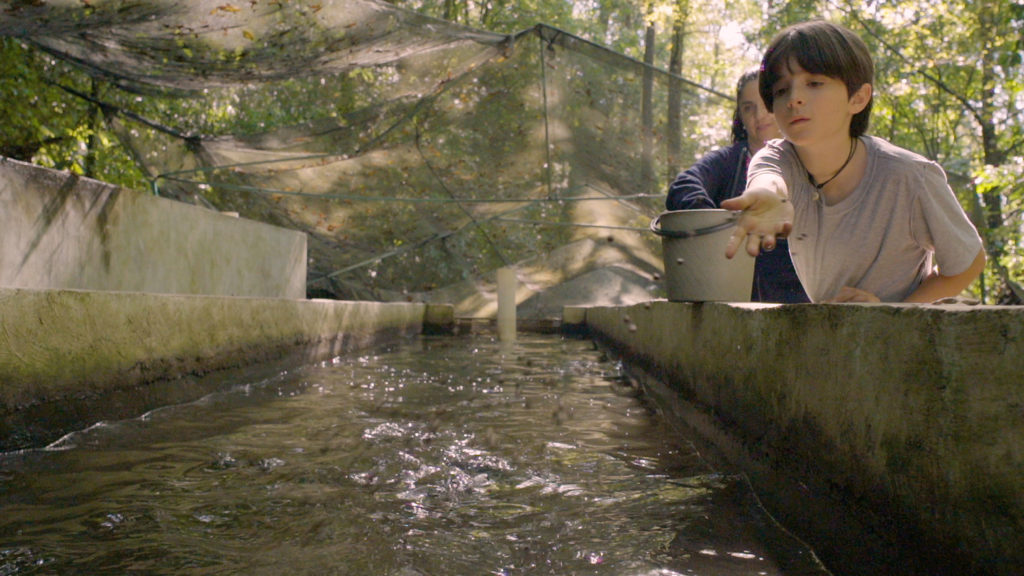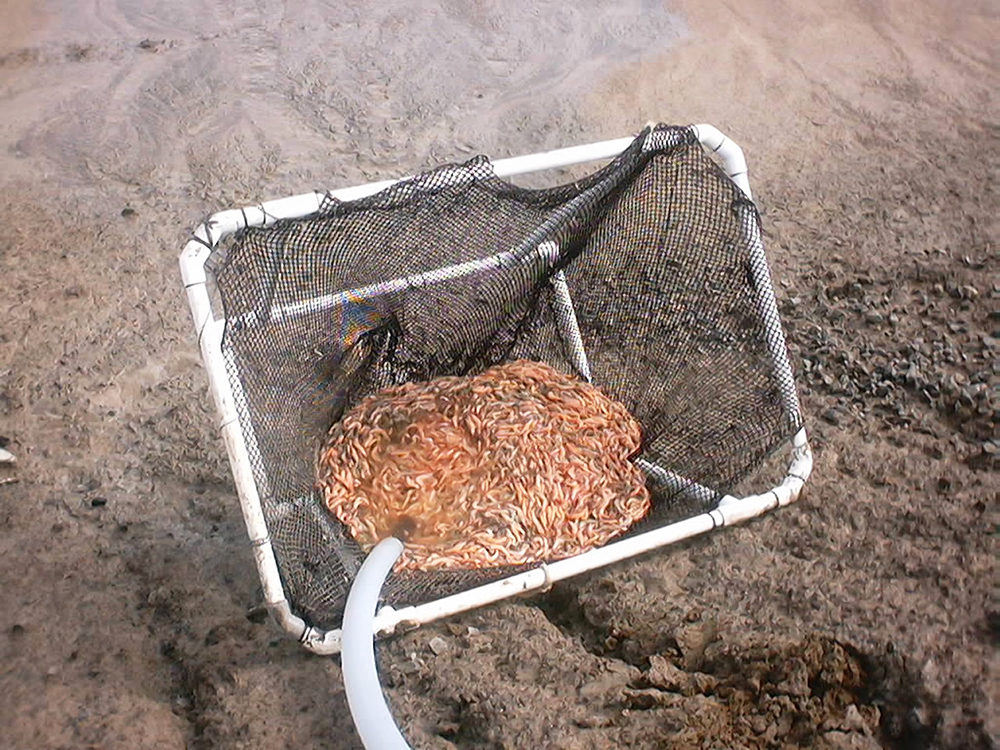Concept for breaking inbreeding/disease feedback loop

In the September/October 2014 issue of the Advocate, the main author suggested that disease crises in tropical shrimp aquaculture and perhaps other kinds of aquaculture are amplified by inbreeding. Increased mortality from disease raises the level of biosecurity regulation, and tightened regulation increases inbreeding that further increases mortality in a self-amplifying feedback loop while disease crises grow worse.
A key component of this hypothesis is that current strategies for countering disease cause, as side effects, progressive reductions in the number, size and genetic diversity of aquaculture gene pools. This is a direct result of biosecurity and stock-transfer restrictions, and an indirect result of higher prices and reduced availability of high-quality stocks as biosecurity tightens.
Generally speaking, the smaller a population is, the faster it accumulates inbreeding. Smallholder farmers, in particular, often rely on seed from small and poorly managed hatcheries. Many such hatcheries are presumed to produce seed that is both inbred and without biosecurity protection.
Do small hatchery broodstocks really have to become inbred? Yes, according to the basic theory of random mating in simple populations of finite size. However, the theoretical answer can be “no” in populations that have more complex structure. In this follow-up to the previous GAA article, the authors suggest aquaculture can be managed at the national level in a way that breaks the link between inbreeding and hatchery size.
National Broodstock Improvement Network
The authors propose a strategy for genetic improvement that might be called a National Broodstock Improvement Network (NBIN) consisting of partially interconnected, but independently evolving broodstocks. The NBIN strategy is complementary to but very different from a traditional nuclear breeding center strategy that has a single, centralized breeding program and one or very few separate gene pools.
The NBIN is a network of aquaculture gene pools, not a network of institutions. To be more precise, it is a network for exchanging information about gene pools. Physical exchange of breeders, fry and postlarvae already takes place just about everywhere aquaculture is practiced.
An NBIN should facilitate the coexistence of any number of public and private broodstocks of different sizes, locations and origins. Traditional nuclear breeding centers could and should be important components of an NBIN, but their main objective – increased yield – would be folded into a wider national strategy for long-term preservation of genetic biodiversity. The NBIN would both assist and make best use of nuclear breeding centers and the myriad small farmer/breeder operations that spring up wherever easily propagated aquatic species such as shrimp, tilapia, carp and catfish are cultured.
How NBINs might work
A National Broodstock Improvement Network would obtain tissue or DNA samples from participating broodstock owners who want to prevent inbreeding by hybridizing their stocks with new breeders. Using information from the DNA, the NBIN would suggest who, among other participants in the network, has broodstock that would be most suitable for reducing inbreeding and/or enhancing performance in any hatchery that requests this advice.
Selective genetic improvement within local broodstocks would remain entirely in the hands of the broodstock operators and would not be a cost burden to the NBIN. Physical exchange of breeders and fry would also be the responsibility of hatchery operators, just as it is now. Biosecurity issues would be handled as they should, but would not be the responsibility of the NBIN, which is solely a network of information flow.
Local exchanges of aquaculture broodstock and seed are popular and somewhat organized in some places. But existing networks are defective in one crucial respect: Their participants lack the genetic information they need to manage inbreeding.
Preserve biodiversity, minimize inbreeding

The strategic goals of an NBIN are to conserve genetic biodiversity at the national level and minimize inbreeding at farm level, thus reducing susceptibility to disease, as well as providing other production benefits. Each local participant benefits by receiving advice on the very best exchanges for each local hatchery.
In the process of providing this advice, the NBIN would facilitate gene flow among broodstock populations of various sizes located in different parts of the country and managed in different ways with different selection objectives and types of ownership. Satisfying the individual needs of local participants would, if calculations on the DNA data are properly done, automatically increase the effective population size and reduce the loss of diversity at the national level.
A wide variety of selection objectives and selection environments are inherent in the NBIN concept because it can extend over a range of environments and farming systems. NBIN participants would constitute a national “meta-population” with all the evolutionary advantages that term implies in terms of environmental resilience, genetic diversity, rapid local adaptation, very large effective population size and minimal inbreeding depression in the component broodstocks.
Inbreeding associated with strong selection would be virtually eliminated by the large effective population size of the interconnected meta-population. Local additive genetic diversity – scope for evolution – would be maintained by gene flow among the component gene pools.
Central laboratory
A central laboratory would be needed to characterize DNA received from participating broodstock owners and also to give advice on what broodstock exchanges or purchases would be most useful for each breeder in the network. The most relevant genetic information would include heterozygosity and genomic diversity, genetic distance from other broodstocks and unique or rare DNA sequences, or those with advantageous expression profiles. Data on local selection environments, history and performance would also be required. Technologies for collecting and analyzing such information are proliferating rapidly and steadily getting cheaper.
Perspectives
The implementation of a National Broodstock Improvement Network would support the protection and development of a genetically diverse array of public and private broodstocks that have a variety of environment- and market-specific genetic characteristics. Although the NBIN concept has never been tried, an NBIN should sustain both genetic biodiversity and genetic improvement at the same time.
Informal, non-secure genetic exchange is taking place all the time in the real world of tropical aquaculture. In the form of broodstock copying, transfers lie at the root of the inbreeding/disease feedback loop. An NBIN should make these ongoing exchanges more beneficial to individual hatcheries and at the same time block the runaway positive feedback loop that is likely amplifying disease problems at the national level.
(Editor’s Note: This article was originally published in the May/June 2015 print edition of the Global Aquaculture Advocate.)
Authors
-
Roger W. Doyle, Ph.D.
Genetic Computation Ltd.
1-4630 Lochside Drive
Victoria, British Columbia, Canada V8Y2T1 -
Cherdsak Virapat, Ph.D.
Director General
Network of Aquaculture Centres in Asia-Pacific
Bangkok, Thailand -
Wongpathom Kamonrat, Ph.D.
Senior Fishery Expert
Aquatic Biodiversity
Thai Department of Fisheries
Bangkok, Thailand
Tagged With
Related Posts

Health & Welfare
Born in Hawaii, SPF broodstock shrimp industry faces globalization
The next step for shrimp breeding will be developing animals that aren’t just disease-free, but increasingly resistant to multiple pathogens. The industry is globalizing, with suppliers setting up shop overseas. But its birthplace will always be Hawaii.

Health & Welfare
A holistic management approach to EMS
Early Mortality Syndrome has devastated farmed shrimp in Asia and Latin America. With better understanding of the pathogen and the development and improvement of novel strategies, shrimp farmers are now able to better manage the disease.

Intelligence
A motive, and a market, for farmed fish in Mexico
Boasting ample areas for aquaculture and a robust domestic demand for seafood – not to mention its close proximity to the U.S. market – a land of opportunity lies in Mexico. Fish farming is primed to meet its potential south of the border.

Aquafeeds
Biosecurity protocols needed for shrimp feeds, feeding practices
Shrimp aquafeeds – live, fresh or formulated – should not be an entry point of potential pathogens to the shrimp and/or to their culture systems.


